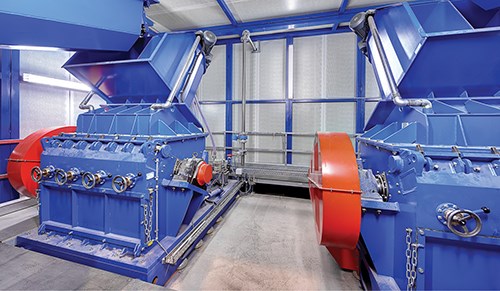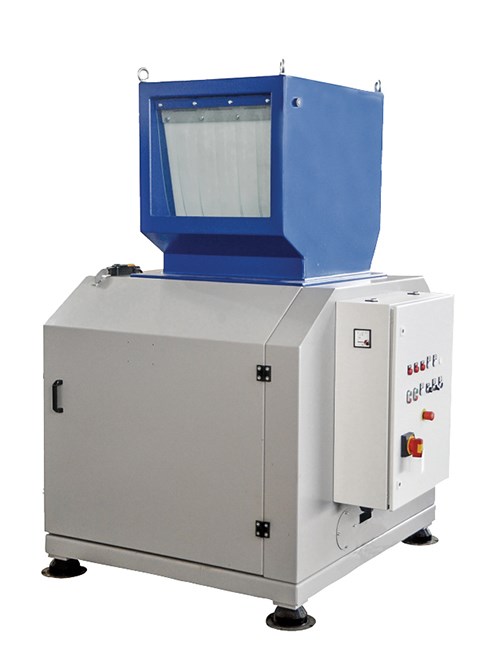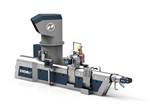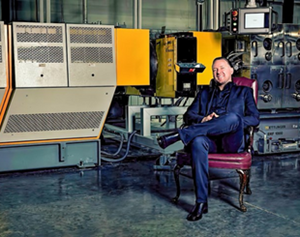RECYCLING AT NPE: Three Es Starred
NPE2015 Wrap-Up
Recycling machinery suppliers focused on environmental, economical, and energy-saving.
March’s NPE2015 show in Orlando featured more news in recycling than perhaps any previous NPE. That’s not surprising: More and more OEMs, brand owners, and big-box retailers are demanding that plastics processors deliver them products containing recycled—in many cases post-consumer—materials. This, in turn, has driven innovations in equipment technology that aim to make recovery more efficient than ever. Here, we report on developments not already covered in previous issues.
Starlinger (Starlinger Sahm in the U.S.) unveiled its recoSTAR dynamic recycling line, which features highly automated operation and continuous process adjustments. This allows increased uptime and productivity while also reducing overall energy consumption by up to 10%. The recycling line starts up and shuts down automatically; and when the material feeding is stopped, the Smart feeder switches into standby mode without operator intervention. Automatic temperature control allows processing of input materials with different moisture content and bulk density.
“This makes it possible to process, for example, post-consumer regrind or fluff that has varying moisture levels,” says Elfriede Hell, general manager of Starlinger. “Under unfavorable storage conditions, the moisture content in the input material can easily increase from 2% to 6%.”
The recycling line automatically adapts to the requirements of the input material and can even process material containing up to 10% moisture with the help of additional equipment. The speed and friction in the Smart feeder are increased until the required material temperature is reached. This can save the operator a lot of process adjustments and also cuts down machine downtime, Hell said.
In addition, the increased capacity of the large Smart feeder results in a much larger operating window, while the self-regulating material feeder allows the extruder to process a wider range of input materials. Additionally, upcycling is achieved by compounding during the recycling process. Additives can be fed directly into the extruder through a side feeder while the output feedback loop ensures total process control.
The recoSTAR dynamic will be the first of the Starlinger recycling lines to carry the “rECO” stamp. With this stamp, Starlinger is highlighting the comprehensive energy-efficient design of the new machine concept.
DRY CLEANING TECHNOLOGY
As reported in our March NPE preview, the Ekuma 700 super cleaner from MAS of Austria made its North American debut at the show. The unit reliably removes thermoplastic contamination from extrusion tools, filter parts, and more. No cleaning agents are required and contaminants are baked off under vacuum without any combustion. This protects the components against local overheating, annealing, and mechanical damage. A cleaning cycle takes 2 to 4 hr depending on part size, at a working temperature of 400-450 C. The unit can be installed in any room with a water supply and drain and an electrical power supply.
Using the phrase “washing without water,” MAS showcased its MAS DRD, a dry cleaning technology for plastic that is an alternative to conventional wet washing lines. The system combines a cleaning centrifuge with thermo-mechanical drying in one step. The double-disc rotor design allows for its use in a range of applications, such as a stand-alone drying and cleaning solution for plastic film and fibers or installation downstream of a wet cleaning plant to improve the quality of the washed flake.
WET GRINDER
Zimmer America Recycling Solutions, North American agent for Germany’s STF Group, displayed STF’s new wet grinder at the show. The unit was developed for both dry and wet shredding of post-consumer plastics and is available in two sizes and with any screen hole size between 8 and 50 mm. By adding water, the shredding process provides a combination of grinding and cleaning. During shredding, around 95% of the paper labels are removed and dissolved in the water.
Also at the ZARS booth was Austrian Recycling Technology (Artec Machinery), which showcased its new Model 500 series recycling and extruder system for the first time in North America. The modular system can be adapted to various customer requirements. The six modules include: material feeder, cutter-compactor, extruder, degassing, filtration, and pelletizing.
NEW TANGENTIAL GRANULATORS
Zerma which recently expanded its operations and sales network to the North American market, introduced a new line of tangential granulators at NPE2015. The company presented its GST series of compact soundproofed granulators featuring a very “aggressive” tangential infeed and cutting chamber. These are available in two rotor diameters, 250 and 400 mm (10 and 16 in.) with widths ranging from 300 to 1000 mm (12 to 40 in.). While the smaller machines feature an open F type rotor, the bigger machines rely on a heavier S rotor. Replaceable wear plates are standard. The newly designed cutting chamber features a curved rear wall to ensure an aggressive ingestion while also avoiding blockages
Related Content
Scaling Up Sustainable Solutions for Fiber Reinforced Composite Materials
Oak Ridge National Laboratory's Sustainable Manufacturing Technologies Group helps industrial partners tackle the sustainability challenges presented by fiber-reinforced composite materials.
Read MoreAdvanced Recycling: Beyond Pyrolysis
Consumer-product brand owners increasingly see advanced chemical recycling as a necessary complement to mechanical recycling if they are to meet ambitious goals for a circular economy in the next decade. Dozens of technology providers are developing new technologies to overcome the limitations of existing pyrolysis methods and to commercialize various alternative approaches to chemical recycling of plastics.
Read MoreHow to Extrusion Blow Mold PHA/PLA Blends
You need to pay attention to the inherent characteristics of biopolymers PHA/PLA materials when setting process parameters to realize better and more consistent outcomes.
Read MoreA Recycling Plant, Renewed
Reinvention is essential at Capital Polymers, a toll recycler that has completely transformed its operation in a short period of time.
Read MoreRead Next
RECYCLING/SCRAP RECLAIM AT NPE: Less Waste And Lower Maintenance
Whether for commercial recycling or in-house scrap reclaim, new systems boast reduced maintenance, higher throughput, and less waste of resin for purging.
Read MoreRECYCLING/SCRAP RECLAIM AT NPE: Less Waste And Lower Maintenance
Whether for commercial recycling or in-house scrap reclaim, new systems boast reduced maintenance, higher throughput, and less waste of resin for purging.
Read MoreTroubleshooting Screw and Barrel Wear in Extrusion
Extruder screws and barrels will wear over time. If you are seeing a reduction in specific rate and higher discharge temperatures, wear is the likely culprit.
Read More



























